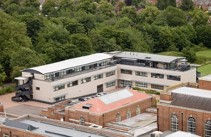College of Science and Engineering
Hercules Facility
 Hercules is an EPSRC funded facility for correlative analysis of crystals in 3D. The facility has a unique combination of X-ray and electron analysis techniques and powerful software to correlate data sets and provide unique insights to material.
Hercules is an EPSRC funded facility for correlative analysis of crystals in 3D. The facility has a unique combination of X-ray and electron analysis techniques and powerful software to correlate data sets and provide unique insights to material.
The project is a collaboration across the college of Science and Engineering at University of Leicester aiming to provide an open, easy to access facility for users both in Leicester and across the UK.
How can we help?
The Hercules project draws upon the expertise of the University of Leicester researchers to provide you with better insight into your materials problems. Whether it is understanding the impact of the microstructure on the macroscopic properties of your material or revealing hidden features, we want to help you.
We aim provide hassle free access for academic or industrial users.
- Simple application process.
- Review with an instrument expert to understand your problem and outline a plan.
- Access to state of the art facilities to analyse your samples.
- Support in understanding the data and next steps.
Profile
 The Hercules project combines large scale x-ray analysis of macroscopic samples with the nanometre resolution of electron microscopy to characterise over multiple length scales.
The Hercules project combines large scale x-ray analysis of macroscopic samples with the nanometre resolution of electron microscopy to characterise over multiple length scales.
It has long been common practice in finite element analysis to use variable length scales to cut down on computation time while still achieving resolution in critical regions of interest. The unique capabilities of the Hercules facility allow this approach to become a physical reality.
Learn more about the combination of different techniques available at different length scales.
Micro-CT
Like a CT machine you might find in a hospital, a Micro-CT is a non-destructive, X-ray imaging technique allowing 3D-reconstructions of macroscopic samples with micrometre (10-6m) precision.
The instrument at Leicester is a cutting edge Xradia CrystalCT allowing for analysis of larger volumes than previously possible in Micro-CT. Included in the capability is a unique lab Diffraction Contrast Tomography (DCT) setup.
Previously confined to synchrotrons, DCT lets us not only see internal structure of a sample but also gain additional information like grain texture that allow characterisation of mechanical properties and failure modes. Likewise an in-situ stage allows you to observe samples under load at a range of temperatures, helping to understand more.
The instrument in Leicester is the first in the country of the new generation of instruments, providing users with easier access to previously inaccessible insights to further their understanding.
LaserFIB
The LaserFIB combines the capability of laser milling with traditional Focused Ion Beam (FIB) in a single instrument, allowing us to quickly reach the region of interest and analyse, all while keeping the sample in a controlled environment.
The femtosecond (10-15s) laser used in Hercules rapidly ablates material with minimal heat and damage to the local area to protect the surrounding material. Milled samples can then be polished to nanometre precision (10-9m) with the gallium Focused Ion Beam (FIB) to either reach the region of interest or create structures for further testing and analysis.
After preparation, Scanning Electron Microscopy (SEM) analysis can be conducted in the same instruments allowing us to understand microstructure & elemental composition. Materials can also be sectioned in-situ by the FIB to giving high resolution information of 3D-volumes, providing more context than typical SEM analysis. This analysis can all then be easily correlated with measurement from the Micro-CT to provide unique understanding of your samples.
The Hercules project is part of the wider UK research community, supported by world class institutes throughout the UK. We can rapidly prepare your samples and connect you with services elsewhere to meet your needs for further techniques like Transmission Electron Microscopy or Atom Probe Tomography.
 Get in touch
Get in touch
We want to hear from you and how Hercules can be your hero.
- Book a chat via email (hercules@leicester.ac.uk) with one of our experts to learn more and understand how we can help.
- Fill out a simple outline and we will get in touch to discuss in more detail.